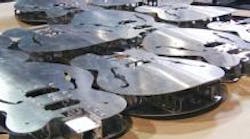Bass electric-guitar player Jim Normandy once shopped around for an archtop guitar — an acoustic guitar with a full body and distinctive arched top. But the $3,000 price stopped him short. “Manufacturers were making custom guitars from solid billeted aluminum. I was still in graduate school and couldn’t afford such instruments. So I decided to make a competitively priced guitar. Instead of wood or plastic, I opted to use 0.080-in. aircraft-grade aluminum sheet metal because of its quality and durability,” says the then-future CEO of Normandy Guitars, Salem, Oreg.
Normandy Guitars, NormandyGuitars.com Zephyr Engineering Inc., zephyreng.com |
Normandy envisioned the guitar having front and back panels, internal supports, and an edge piece. “I began with a lot of pencil and paper work, calculating such factors as how much extra material would be needed under the 0.080-in. skin so the bridge could screw directly into it and withstand the pull of the strings,” he says. “I also calculated the stress of the arched top pulling on the bottom. You don’t want the guitar to fail, but weight constraints forestall just beefing up the instrument inside so it will never break. The guitar becomes much too heavy. Also, it’s necessary to account for neck weight. When the guitar is worn with a strap and the guitar neck is too light, it tips down, certainly not conducive to good playing,” he says.
Viewed through the pickup holes, the inside of the guitar is intended to look like the inside of an airplane wing, with support arches and trusses, says Normandy. This makes for a lot of stress from the arched top. The back of the guitar is completely flat. If the support forces were incorrect, it would bow.
Normandy began by drawing the guitar in 2D CAD. “A friend cut the aluminum sheet into front and back panels, riveted internal bracing to them, and welded the outside edge for a finished prototype,” he says. “The first one was way too heavy.”
Eventually, Normandy brought in Zephyr Engineering Inc., Salem, Oreg., to build a model of the guitar in 3D CAD and manufacture the guitars in a production environment. “Special software lets us take the 3D CAD model, convert files into 2D DXF format, and import them into the laser-programming software,” says Project Manager Doug Jones. “We then kick code out to the CNCs via CAM for the few machined parts the guitars need.”
The shop laser cuts bodies, including rivet holes, in large groups, says Jones. It sends panels out for finishing with chrome, powder coat, or anodizing. This is mostly for aesthetics, but also protects the surface. When the panels are returned, the company manually rivets internal bracing to the front and back panels on a modified World War II-era press with a foot-activated lever.
“The archtop shape is difficult to make in sheet metal because it’s a compound arch, says Jones. “There is an arch from right to left and also from top to bottom. We form the arch in a press brake by making a center bend down the middle of the piece, and then clamping and pulling edges to a two-inch width.” The company lets only its veteran TIG welders assemble the guitars because heat from welding can easily warp or blow a hole in the aluminum.
About the Author
Leslie Gordon
Leslie serves as Senior Editor - 5 years of service. M.S. Information Architecture and Knowledge Management, Kent State University. BA English, Cleveland State University.
Work Experience: Automation Operator, TRW Inc.; Associate Editor, American Machinist. Primary editor for CAD/CAM technology.
